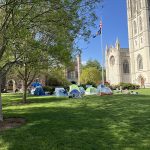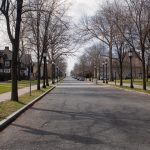On September 16th, an alumnus and a number of Trinity students intended to stage a peaceful protest against white supremacy at the homecoming football game against the Colby Mules. Protestors planned to begin at halftime, to interfere with the game itself. According to an organizer who wishes to remain silent, the protest was to be a response to the general controversy surrounding Professor Williams’ comments on social media and President Trump’s cancellation of DACA. Organizers and participants were not part of any Trinity-affiliated official organization. The gathering would have been a necessary example of political activism on Trinity’s campus. Despite widespread advertisement, the event fell through. At first, over 100 students expressed enthusiastic interest. On the day of, however, only four people showed up, three of whom were international students. One was a faculty member. An organizer who was there attributes the lack of attendance to one central factor: many protestors wanted to act spontaneously. Instead, the protest was advertised with posters around campus and formally announced to the administration. A protest indeed has a greater effect when it is unannounced. It is more real. However, an inadequate build-up to a protest should not be a reason to not protest. The drive to stand up for one’s beliefs should be enough. But not at Trinity.
In years past, a culture of activism has sprung up around different issues at Trinity. In the wake of unrest at the University of Missouri in 2015, there was a protest at halftime of the Homecoming football game. After President Trump’s election, the Action Coalition of Trinity (ACT) formed. This protest could have been a revival of Trinity’s small, if vocal, activist culture. “The left” on campus, however one wants to understand it, had an opportunity to make a strong statement, not only in regards to the incident regarding Professor Williams, but about the stance of students about unfolding events both on campus and throughout the nation. A significant factor in the failure of the protest was its lack of advertising. The organizers, understandably, wanted the protest to form organically, and thus resisted traditional advertising methods. The deafening silence that doomed the protest demonstrates the lack of organization of activists. Strong movements could coalesce around a number of issues at Trinity. The ACT showed what a few motivated people could accomplish with a set of priorities and a strong sense of purpose.
The list of demands that they posted almost a year ago may not have been perfect, and was met with derision by certain groups on campus, but it signified a unity of purpose, a collective desire for change. That was not a full-fledged movement, but it was a start. The failed protest this week was certainly a missed opportunity. Better communication among groups agitating for change on Trinity’s campus will certainly mitigate these “swing and a miss” situation. In a larger sense, however, activist groups and the “campus left” need to get to know one another, to identify common goals, and to advance practicable agendas that meaning. -crbfully engage with the issues confronting Trinity’s campus. Whether classes and faculty, political groups, or even the pages of The Tripod serve as the forum for argument, discussion needs to begin in earnest. Trinity’s activist culture can no longer afford to keep moving in fits and starts. It is High Noon, and the showdown has already started. Trinity’s left cannot afford to not show up.
Monday, May 20 2024
The Student Newspaper at Trinity College in Hartford, Connecticut





+ There are no comments
Add yours